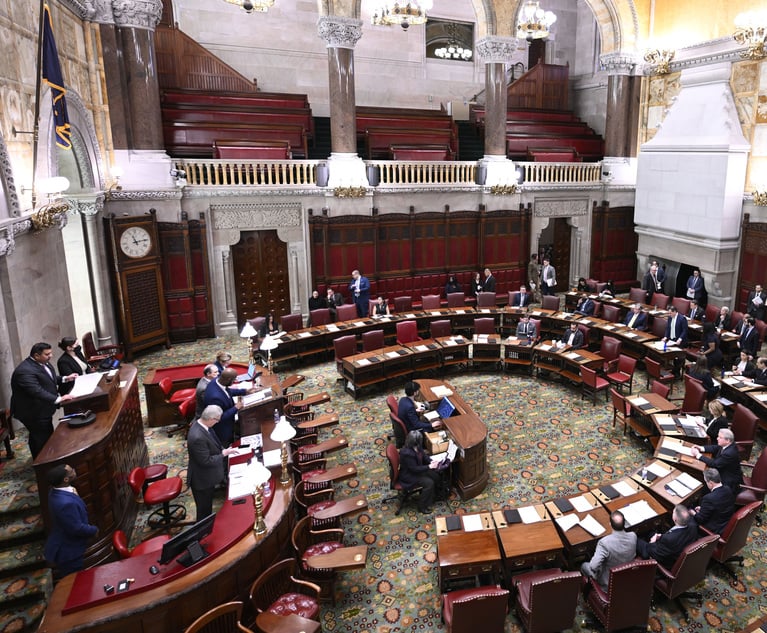Shift of Residence/Domicile From New York to Florida: Part 1
This article is intended to provide a legal analysis of change of domicile under New York law and its residency audit process.
August 06, 2019 at 11:00 AM
9 minute read
 New York’s high income tax rates have prompted some high-income taxpayers to relocate to lower-tax states, such as Florida and Texas. Consequently, fiscal revenues in New York have suffered and, not surprisingly, audits of taxpayers asserting a change in domicile have increased. New York conducts roughly 3,000 nonresidency audits annually and has collected approximately $1 billion in revenue between 2010 and 2017 as result of these audits. The Tax Cuts and Jobs Act of 2017 capped the federal income tax deduction at $10,000 for state and local income taxes, which will likely result in an increase in the number of high income taxpayers changing domicile to a low tax state.
New York’s high income tax rates have prompted some high-income taxpayers to relocate to lower-tax states, such as Florida and Texas. Consequently, fiscal revenues in New York have suffered and, not surprisingly, audits of taxpayers asserting a change in domicile have increased. New York conducts roughly 3,000 nonresidency audits annually and has collected approximately $1 billion in revenue between 2010 and 2017 as result of these audits. The Tax Cuts and Jobs Act of 2017 capped the federal income tax deduction at $10,000 for state and local income taxes, which will likely result in an increase in the number of high income taxpayers changing domicile to a low tax state.
This article is intended to provide a legal analysis of change of domicile under New York law and its residency audit process. While this article focuses on relocation to Florida, a state which imposes no personal income tax, issues and analysis are similar in the case of other low-tax destinations.
Introduction
At the outset, a couple of terms should be distinguished—“domicile” and “residence.” Although people often use these terms synonymously, each has a technical meaning. You can have plenty of residences, but only one domicile. Domicile is largely subjective; it is the place to which you always intend to return. Due to the migratory nature of affluent taxpayers—with some maintaining three or more homes and not spending much time in any one place, the determination of domicile has become increasingly complicated.
Taxpayers domiciled in New York are subject to income taxes and estate taxes in New York. There is a statutory exception from income tax for a New York domiciliary who is not physically present in New York for more than 30 days in a calendar year, does not have a permanent place of abode in New York and has a permanent place of abode outside of New York during the entire year.
Once established, the presumption is that a taxpayer’s domicile continues until it is proven that it has been changed. The burden to prove change of domicile is on the party asserting the change and must be established by “clear and convincing proof.” Florida generally welcomes individuals to become domiciliaries of that state. The challenge in changing domicile for tax purposes is not to have Florida recognize a taxpayer as domiciled in Florida, but rather for New York to recognize that the taxpayer is no longer domiciled in New York. While Florida is a low-tax state, concerns of dual residence may arise if the taxpayer does not complete the necessary steps to effectively change domicile.
New York has published the Nonresident Audit Guidelines (the Guidelines), to provide guidance to its auditors conducting a “residency audit” in determining if the taxpayer is a domiciliary of New York. The Guidelines were last updated in 2014 and can be found on the New York State Department of Taxation and Finance website. In addition to evaluating change of domicile, residency audits are conducted to determine if a taxpayer is subject to tax based on “statutory residence” or if an allocation of income to New York State is required.
A favorable residency audit result has some precedential effect for a future residency audit. A favorable audit result is formal New York tax authority recognition that the taxpayer is not domiciled in New York. The taxpayer would have to reacquire New York domicile for the tax authorities to prevail in a future audit. The practical effect is that some taxpayers may be willing to agree to a monetary settlement for one year in order to secure a tactical advantage in the case of any future audit, either for income tax or estate tax purposes.
Statutory Residence and Initial Part-Year Residency
A taxpayer who is not a domiciliary of New York can still be taxed as a New York resident if the taxpayer is a “statutory resident.” A statutory resident is someone who maintains a permanent place of abode in New York and spends 184 days or more during the year in New York. A person who meets these criteria will be taxed as a New York resident, even if the person is domiciled in another state. A partial day spent in New York counts as an entire day for purposes of the statutory residence test.
If a taxpayer wishes to change residence from New York to Florida during the calendar year, the same “factor” analysis (discussed below) will apply for the second portion of the year, taken in isolation. This can be important for a taxpayer who has sold a New York closely-held business (particularly if a portion of the sales price is paid post-closing). In planning for a part-year residency election, however, the statutory residence rule (184 days in New York) applies for the entire year, and that may cause a part-year election that might otherwise be successful to fail if the taxpayer is in New York 184 days during the entire calendar year.
Establishing Change of Domicile
The Guidelines address two basics elements to establish a domiciliary change: (1) residence in a new location; and (2) intention to make the new location their permanent “home.” There must be a good faith intention coupled with overt acts. The Guidelines provide five “primary” factors to be considered in determining a taxpayer’s domicile: Home; Active Business Involvement; Time; Items Near and Dear; and Family Connections. The Guidelines indicate that no single primary factor is determinative of domicile.
If analysis of the primary factors does not establish a change of domicile by clear and convincing proof, then the Guidelines provide seven “other” factors that an auditor can consider. Information concerning the “other” factors should only be considered by an auditor in cases where the primary factors do not establish a change of domicile. The five primary factors are discussed in detail.
Five Primary Factors
(1) Home. If a taxpayer sells their home, and does not purchase or lease a replacement home in New York, then this factor usually is decided in favor of a change in domicile. Challenges arise when the taxpayer has acquired a new home in the place where the taxpayer asserts a new domicile and retains a home in New York, or purchases or leases a replacement home in New York. Auditors will analyze the home and community in each place. The Guidelines indicate that the retention of a home is a strong indication that domicile has not changed; and further, that “‘home’ refers not only to the family residence, which over the years has been clearly established and accepted by everyone as ‘home’ to the taxpayer and/or their immediate family, but also the community to which the individual has established strong and endearing ties.” From the perspective of the Guidelines, a long-time resident of New York usually has a sentimental attachment to the area, as well as the dwelling, in which they reside; and consequently, selling or disposing of that dwelling does not necessarily change the attachment the taxpayer has for the area if a new residence is acquired within that area. Therefore, retention or replacement of a home is a strong indication that domicile has not been changed. However, the Guidelines specifically emphasize that retention of a home, by itself, is not sufficient evidence that the taxpayer did not change domicile,
Auditors have been instructed to give appropriate weight to facts such as whether the taxpayer has sold and moved possessions from a home or contracted with a real estate firm to sell the property. However, auditors have been alerted to recognize situations in which the taxpayer is not really actively trying to sell their home.
Auditors are also instructed to compare the size and value of the residences in each state. Another aspect considered by auditors is how the taxpayer uses a particular dwelling. For example, the length of time the property is used each year is a fact to be considered. Other aspects of the home factor are employees such as housekeepers, grounds keepers, chauffeurs, etc.
Some taxpayers may be inclined after selling a principal residence in New York to make a clean break and not maintain any residence in New York for a period of time (say, for a period that includes at least one calendar year)—although there can be no assurance of success if a New York residence is later acquired.
For New York taxpayers who are considering selling their primary home in New York and retiring to Florida, who also plan to maintain a home in New York, there is reason to consider making the effective date for Florida relocation to be upon the real estate sale closing (or earlier), with a view towards countering the argument that the taxpayer’s domicile was attached to the new New York home.
This is part one of a two-part article dealing with a taxpayer’s domicile and residence status as it pertains to tax planning. The other four primary factors used in determining a taxpayer’s domicile—the location of an active business, time spent in the states at issue in the audit, the location of items near and dear to the taxpayer, and the location of family connections—are discussed in Part 2 of this article.
Hollis F. Russell, Gail W. Marcus, Stuart M. Gottlieb and David A. Kellman are partners at McLaughlin & Stern. Mr. Russell is resident in the New York and Florida offices, Mr. Gottlieb is resident in the Florida office and Mr. Kellman and Ms. Marcus are residents of the New York office. Jacob Neumark, a summer intern at the firm, contributed to the preparation of this article.
This content has been archived. It is available through our partners, LexisNexis® and Bloomberg Law.
To view this content, please continue to their sites.
Not a Lexis Subscriber?
Subscribe Now
Not a Bloomberg Law Subscriber?
Subscribe Now
NOT FOR REPRINT
© 2025 ALM Global, LLC, All Rights Reserved. Request academic re-use from www.copyright.com. All other uses, submit a request to [email protected]. For more information visit Asset & Logo Licensing.
You Might Like
View All
Relaxing Penalties on Discovery Noncompliance Allows Criminal Cases to Get Decided on Merit
5 minute read
Bipartisan Lawmakers to Hochul Urge Greater Student Loan Forgiveness for Public-Interest Lawyers

'Playing the Clock'?: Hochul Says NY's Discovery Loophole Is to Blame for Wide Dismissal of Criminal Cases

So Who Won? Congestion Pricing Ruling Leaves Both Sides Claiming Victory, Attorneys Seeking Clarification
4 minute readTrending Stories
- 15th Circuit Considers Challenge to Louisiana's Ten Commandments Law
- 2Crocs Accused of Padding Revenue With Channel-Stuffing HEYDUDE Shoes
- 3E-discovery Practitioners Are Racing to Adapt to Social Media’s Evolving Landscape
- 4The Law Firm Disrupted: For Office Policies, Big Law Has Its Ear to the Market, Not to Trump
- 5FTC Finalizes Child Online Privacy Rule Updates, But Ferguson Eyes Further Changes
Who Got The Work
J. Brugh Lower of Gibbons has entered an appearance for industrial equipment supplier Devco Corporation in a pending trademark infringement lawsuit. The suit, accusing the defendant of selling knock-off Graco products, was filed Dec. 18 in New Jersey District Court by Rivkin Radler on behalf of Graco Inc. and Graco Minnesota. The case, assigned to U.S. District Judge Zahid N. Quraishi, is 3:24-cv-11294, Graco Inc. et al v. Devco Corporation.
Who Got The Work
Rebecca Maller-Stein and Kent A. Yalowitz of Arnold & Porter Kaye Scholer have entered their appearances for Hanaco Venture Capital and its executives, Lior Prosor and David Frankel, in a pending securities lawsuit. The action, filed on Dec. 24 in New York Southern District Court by Zell, Aron & Co. on behalf of Goldeneye Advisors, accuses the defendants of negligently and fraudulently managing the plaintiff's $1 million investment. The case, assigned to U.S. District Judge Vernon S. Broderick, is 1:24-cv-09918, Goldeneye Advisors, LLC v. Hanaco Venture Capital, Ltd. et al.
Who Got The Work
Attorneys from A&O Shearman has stepped in as defense counsel for Toronto-Dominion Bank and other defendants in a pending securities class action. The suit, filed Dec. 11 in New York Southern District Court by Bleichmar Fonti & Auld, accuses the defendants of concealing the bank's 'pervasive' deficiencies in regards to its compliance with the Bank Secrecy Act and the quality of its anti-money laundering controls. The case, assigned to U.S. District Judge Arun Subramanian, is 1:24-cv-09445, Gonzalez v. The Toronto-Dominion Bank et al.
Who Got The Work
Crown Castle International, a Pennsylvania company providing shared communications infrastructure, has turned to Luke D. Wolf of Gordon Rees Scully Mansukhani to fend off a pending breach-of-contract lawsuit. The court action, filed Nov. 25 in Michigan Eastern District Court by Hooper Hathaway PC on behalf of The Town Residences LLC, accuses Crown Castle of failing to transfer approximately $30,000 in utility payments from T-Mobile in breach of a roof-top lease and assignment agreement. The case, assigned to U.S. District Judge Susan K. Declercq, is 2:24-cv-13131, The Town Residences LLC v. T-Mobile US, Inc. et al.
Who Got The Work
Wilfred P. Coronato and Daniel M. Schwartz of McCarter & English have stepped in as defense counsel to Electrolux Home Products Inc. in a pending product liability lawsuit. The court action, filed Nov. 26 in New York Eastern District Court by Poulos Lopiccolo PC and Nagel Rice LLP on behalf of David Stern, alleges that the defendant's refrigerators’ drawers and shelving repeatedly break and fall apart within months after purchase. The case, assigned to U.S. District Judge Joan M. Azrack, is 2:24-cv-08204, Stern v. Electrolux Home Products, Inc.
Featured Firms
Law Offices of Gary Martin Hays & Associates, P.C.
(470) 294-1674
Law Offices of Mark E. Salomone
(857) 444-6468
Smith & Hassler
(713) 739-1250






